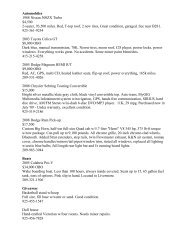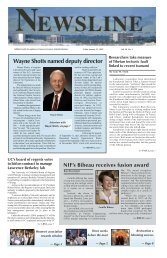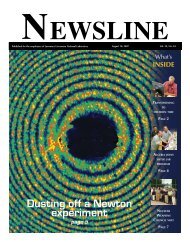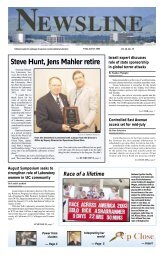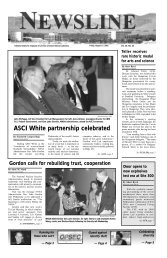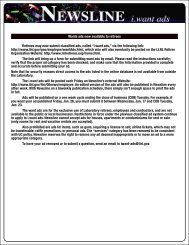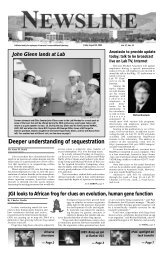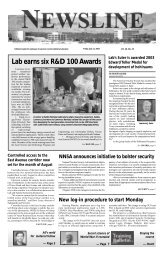JASPER gas gun - NEWSLINE - Lawrence Livermore National ...
JASPER gas gun - NEWSLINE - Lawrence Livermore National ...
JASPER gas gun - NEWSLINE - Lawrence Livermore National ...
You also want an ePaper? Increase the reach of your titles
YUMPU automatically turns print PDFs into web optimized ePapers that Google loves.
4<br />
Newsline<br />
COVER STORY<br />
By David Schwoegler<br />
Newsline Staff Writer<br />
“The <strong>JASPER</strong> team successfully executed our<br />
first plutonium shot today at 2:35 p.m.. The data<br />
demonstrate superb quality, and a preliminary analysis<br />
indicates that <strong>JASPER</strong> will meet its intended goal<br />
of generating high-precision plutonium data. Initial<br />
re-entry surveys show full containment. The shot<br />
specifics were 5.22 km/s (11,677 mph or mach15.74),<br />
firing a 13-pin, heavy projectile weighing about 30<br />
grams or 1 oz.”<br />
So began an enthusiastic e-mail from [then] test<br />
director Mark Martinez immediately following the<br />
shot on July 8, 2003.<br />
That day the Laboratory achieved a major milestone<br />
and began an impressive scientific legacy of<br />
successful firings for the <strong>JASPER</strong> Gas Gun at the<br />
Nevada Test Site. Starting in March 2001, the <strong>gas</strong><br />
<strong>gun</strong> completed a series of 20 inert or non-nuclear<br />
shots to qualify it for use with nuclear materials. That<br />
first Plutonium shot marked the culmination of years<br />
of effort in facility construction, <strong>gun</strong> installation, system<br />
integration, design reviews and authorizations to<br />
bring the experimental facility on line.<br />
The <strong>gun</strong>’s winning streak has continued until<br />
today. Successful shots are no longer big news. Even<br />
though all the details may not have been inked in<br />
print, the cumulative results remain amazing. In total,<br />
<strong>JASPER</strong> has racked up 48 shots: all successful. That<br />
number includes 17 plutonium shots and 31 experi-<br />
ments involving surrogate materials. The most prolific<br />
calendar year was 2004, when 15 shots were fired.<br />
<strong>JASPER</strong>, an acronym for Joint Actinide Shock<br />
Physics<br />
Experimental<br />
Research, is a<br />
nearly 100-foot,<br />
two-stage <strong>gas</strong><br />
<strong>gun</strong>, built at a<br />
cost of $20 million<br />
inside existing<br />
facilities<br />
within Area 27<br />
at the Nevada<br />
Test Site. Inside<br />
the <strong>gun</strong>’s first<br />
stage, hot <strong>gas</strong>es<br />
from burning<br />
<strong>gun</strong>powder drive<br />
a heavy piston<br />
down a pump<br />
tube, compressing<br />
hydrogen<br />
<strong>gas</strong>. That <strong>gas</strong><br />
builds up to<br />
extremely high The <strong>JASPER</strong> <strong>gas</strong> <strong>gun</strong> target chamber.<br />
pressures, breaks<br />
a valve, then enters the narrower barrel of the second<br />
stage, propelling the projectile — which is housed in<br />
the barrel — towards the target. <strong>JASPER</strong> can fire<br />
small projectiles at velocities of up to eight kilometers<br />
(five miles) per second, which is nearly18,000<br />
miles per hour, or more than 24<br />
times the speed of sound. And<br />
<strong>JASPER</strong>’s economics are highly<br />
cost-effective. The <strong>gun</strong> potentially<br />
can fire up to 24 experiments per<br />
year, and costs about $6 million<br />
annually, with an expected 10-year<br />
lifetime.<br />
March 3, 2006<br />
<strong>JASPER</strong> <strong>gas</strong> <strong>gun</strong> builds legacy of shock physics success<br />
The <strong>JASPER</strong> two-stage <strong>gas</strong> <strong>gun</strong> at the Nevada Test Site.<br />
Since 1998, Neil Holmes has been a<br />
pacemaker for the scientific heartbeat at<br />
<strong>JASPER</strong>. Test directors have come and<br />
gone. So have <strong>Livermore</strong> site managers<br />
and N-Program leaders at NTS. But everpresent<br />
as project scientist, Holmes has<br />
been a linchpin of continuity and stability<br />
in this successful string of shock-physics<br />
experiments.<br />
After receiving his Ph.D. in physics<br />
from Stanford University, Holmes joined<br />
the Lab in 1977. He says the highlights of<br />
his <strong>Livermore</strong> career are the high-quality<br />
data gleaned from the <strong>JASPER</strong> shots, coupled<br />
with the high-caliber team that puts<br />
those shots together. A serious gourmet,<br />
Holmes added jocularly that, “The food<br />
has gotten much better in Las Ve<strong>gas</strong>, too.”<br />
Holmes wants to complete more major<br />
plutonium milestones at the Nevada <strong>gas</strong><br />
<strong>gun</strong> before he even thinks about retirement.<br />
In the meantime, this single physicist<br />
will continue to mastermind the sci-<br />
Although similar two-stage light <strong>gas</strong> <strong>gun</strong>s have<br />
been in operation at <strong>Lawrence</strong> <strong>Livermore</strong>, Los<br />
Alamos and Sandia national laboratories for many<br />
years, they cannot perform<br />
experiments on plutonium,<br />
other actinides or other hazardous<br />
materials. <strong>Livermore</strong><br />
operates <strong>JASPER</strong>, but the<br />
<strong>gun</strong> sees multi-laboratory<br />
experimental use.<br />
In the absence of fullscale<br />
nuclear testing,<br />
<strong>JASPER</strong>’s role in Science<br />
Based Stockpile Stewardship<br />
— along with subcritical<br />
experiments — is to help<br />
assess the properties of nuclear<br />
weapon materials to verify that<br />
aging weapons can perform as<br />
designed. An important experimental<br />
technique to determine<br />
the properties of materials at<br />
high temperatures, pressures<br />
and densities is to shock the<br />
material, then measure its<br />
response, according to chief<br />
scientist Neil Holmes.<br />
So Lab scientists fire a tantalum projectile at over<br />
five kilometers per second at a plutonium target. The<br />
impact produces a high-pressure shock wave that<br />
passed through the target in a fraction of a microsecond.<br />
During this extremely brief period, diagnostic<br />
equipment measures the properties of the shocked<br />
plutonium inside the target. These shock-physics<br />
experiments complement ongoing subcritical experiments<br />
at the Nevada Test Site. “<br />
<strong>JASPER</strong> continues to validate itself as a vital tool<br />
for plutonium shock physics. Everything has worked<br />
exactly as planned. We now are looking forward to<br />
shot number 49,” said Holmes.<br />
Holmes is a driving force behind <strong>JASPER</strong> success<br />
ence at<br />
<strong>JASPER</strong>,<br />
while he leads<br />
a double life in<br />
San Joaquin<br />
County as a<br />
professional<br />
large-format<br />
photographer<br />
and photography<br />
instructor.<br />
Holmes says<br />
one pet ponderable<br />
he<br />
wants to learn Neil Holmes<br />
is, “How do<br />
materials return to an equilibrium state<br />
after they’ve been shocked?”<br />
While there is no formal betting line<br />
on this topic at the Las Ve<strong>gas</strong> sport books,<br />
one bet is that the Lab’s top <strong>gas</strong>-<strong>gun</strong>slinger<br />
at NTS will find an answer long before he<br />
pulls the pin on his career.




